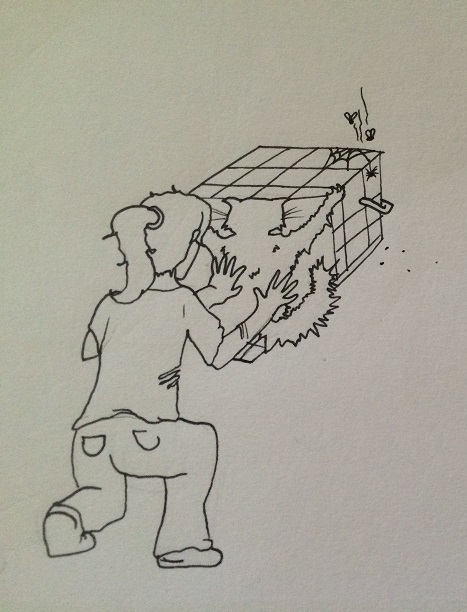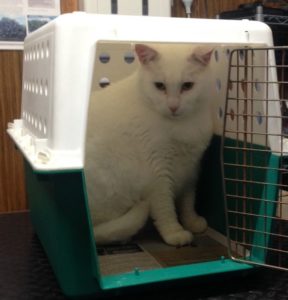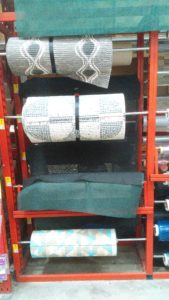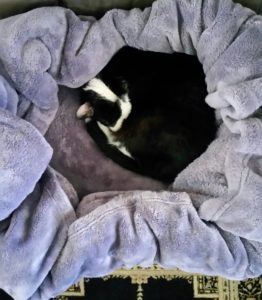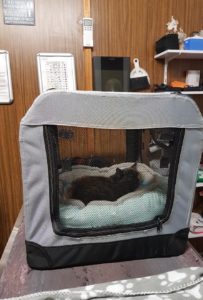First publishd May 2018
We need to turn our attention to the size and design of ‘Cat Carriers’ that are used to take cats on car journeys, especially if the purpose of that car journey is to take the cat to the Vet.
Remember, it may be one thing for your cat to hide in small spaces at home but they can free themselves when they want to. That same cat can’t free himself from a small cage in a bumpy hot car journey. “Pain is both about the pain you feel and how that pain makes you feel”; usually not amenable to other living things touching you. Once you realise that, you can begin to understand why cats have hated being shoved into traditional cat carriers.
I wrote this blog post after sitting in a conference lecture on behaviour and having to bite my tongue (not something I usually do), as the audience was shown how a cat was “trained” to accept its cat carrier. It took the owners and their cat a week but eventually, the cat went into the cage without a struggle. I so wanted to put my hand up and suggest I could have gotten the cat to accept the cage in minutes. Why? Because I would have used a different cage. No one else seemed to notice how tiny the carrier box was relative to the cat. We don’t force our children to wear shoes several sizes too small, nor tie dogs up in harnesses that cramp their movement: yet we constantly want to shove cats into boxes/carriers that are simply too small. Surprise surprise, the cat doesn’t cooperate – well, fancy that!
For many cats, simply changing the style of cat carrier they travel in can have a huge positive improvement on the cat’s behaviour.
It is a given that all cats should travel to a vet clinic is a safe carrier of some sort; but I strongly discourage the use of most of the popular traditional cat carriers for my clients. I do so because often I seen adult cats transported to me in the very same cat basket bought when the kitten was first purchased; which was perfect for the little kitten, not so for a fully-grown cat. As a result, you end up at the vet clinic with: a hot, stressed, cramped, often highly painful cat, (sometimes two cats), who has/have simmered into the Red zone of fear and aggression by the time the carrier box and its inmates get to the Vet clinic. So begets a lifelong tale of woe.*
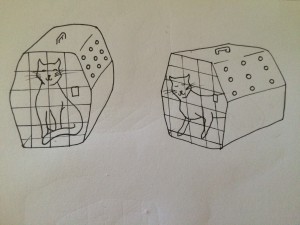
Instead, I encourage clients to use a small dog basket or transport box; these tend by default to be of a squarer, taller shape so that even a tall cat can walk into it without crouching and can then settle comfortably inside. Most of the dog carry cages have a wider door width which is kinder on the cats’ whiskers as well.
Importantly, many dog cages also tend to have air vents or slots on the sides shaped either as circles or portholes, rather than the long narrow vertical slatted slit style seen on many cat cages. I am suspicious that the rows of those narrow slit lines on the cage top-side may create a strobing-light action as the car moves along, by which many cats would be quite distressed.
The photograph below shows a 10kg (22lb) large male cat sitting calming in a dog carrier.
However, that was not how he started out. A new client had presented me with a small plastic cage which “contained” this huge cat… The elderly owner and companion were covered in plasters as a visual testament to their struggle to get this cat into the cage. The owners were completely unfazed and reported their struggle as simply the norm for the previous 8 years of this cranky cat’s life. The cat extirpated himself as fast as any oversized animal could exit an undersized container. After the cat was finished being examined by me, the owner lifted the original blue carrier back onto the consult table-whereupon the cat turned and nipped the owner then turned towards me as if to say ” You’re next”. I walked out of the room, came back in with the green and white carrier box shown above and invited the cat to enter-which he did calmly then and for many trips after. The cat loved the bigger box, happily going in and out of it at home. At the vet clinic, he would sit calmly in it with the door open in it until I was ready for him, then allow a certain amount of physical interference by me, then walk calmly back into the box signalling Detente was over. He allowed us about 60 seconds to close the door, any longer and the spitting and slashing would start. Problem solved.
Some cats love to look out and see where they are going which they can easily do sitting in the ‘wire mesh top with solid plastic bottom’ style of carry boxes. If the cat is of the type that prefers to hide, then a light towel over 3 sides of the box does the trick.
A new emerging trend in cat carriers is light weight sturdy cat carrier bags that fold down and away after use. They provide size without weight and have non-slip floors. These carry cases open out and up so cat can walk full height into the long length without painful crouching, can be allowed to settle down, then zipped in. Just like you need to ensure the lock on the door and sides are firmly in place in a plastic carrier box, you need to ensure the zippers are fully closed. Consider a quick release lock on the zips-as on suitcases- so the cat is safe inside, but you the owner or your vet can still open the bag quickly if needs be.
I was impressed with this version which our clever client kindly allowed us to photograph to display and share with others.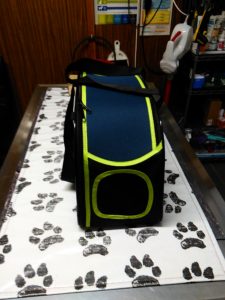
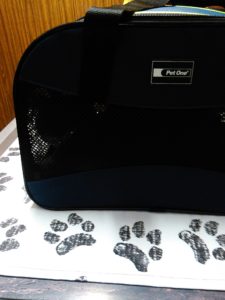
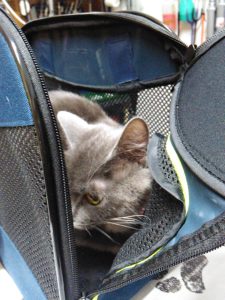
More on the portable carrier bags* at the end of this post.
Now that you have sorted out the design and size of transport cage for your cat, you need to teach it to love the cage as a happy safe part of the furniture in its home. Cats preferences are extraordinarily fickle, one day sleeping right next to you, next in the linen closet away from everyone, sprawled flat out long on outdoor furniture in the morning (Exhibit 1 to 3), then tucked up asleep in the shovel-pan later (Exhibit 4).

Exhibit 3
As a result of this fickle nature, you need to use the transport boxes or cages as some of those home beds and also as treat- treasure- troves in the house for your cat from day 1. Do not have the carry cage stored in the garage so it only appears suddenly and always to go somewhere unpleasant. We vets can tell by how dusty and spiderweb covered a cage is as to how impressed that cat was going into it at home, usually not at all…
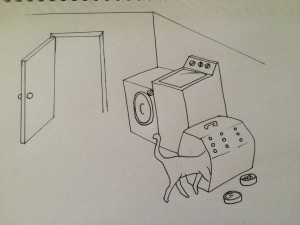
Depending on the cat’s personality, I either leave them in a quiet calm area like the laundry or, in the case of my demanding heat-loving Siamese, I leave the boxes where the morning sun can stream in and warm the outside of the boxes. I leave special small food treats such as cooked chicken meat, tuna cubes, Hills Metabolic Treats or dried liver treats or else a new toy mouse to find in the boxes to keep the cats curious about what might be in the boxes at any given time. Healthy cats also have a much higher heat requirement that humans, they prefer the 30-38C range so leaving a heat pack in there even in summer can make the carrier very attractive to most cats as most cats spend their day searching for warm hot spots to rest in. Having the heat pack in the carrier makes the carrier more attractive but do no lock the cat in as they need to be able to move away if the pack is too hot for them.
Providing an appropriately sized carrier and positive training from Day 1 so that the carrier comes to represent safety and comfort for your cat has many benefits beyond just an occasional reduced stress visit to the vet. In instances of house fires or emergency evacuations from your home, you need your cat to be onside and co-operative about entering his carrier as that so not the time to be chasing a reluctant cat around the house fighting to get them into a carrier. Equally, having the cat content in the box means any stay in an overnight emergency shelter becomes less frightening for the cat as the cats have a little bit of home to snuggle down in.
Additional tips;
- Really stressed cats get their cages topped up with a Feliway spray on a regular basis and especially on the day of the vet visit. If you are not asthmatic, then we also have the owner lightly spray inside the car where the cat will sit about 20 minutes before the car journey.
- If the cage size is big enough then plastic cages are still fine but you can still modify a large plastic cage to be even more comfortable.Regardless of design style, making the floor non-slip is important. A strip of grip material from the reject shops or Bunnings as show in photo below is a good start.. Consider putting down some fleece bedding. Cats prefer fleece above all materials. Making the fleece cloth into a cocoon shape (in the style of the second photo below, but a lot smaller obviously) provides additional comfort to the cat.
- one of the upsides of the carrier bag style is the double-handle bag strap style does seem to make it easier for the owner to carry. The bags swing less, which the cats also prefer, but if you carry the plastic cat cage in your arms (or come and get the nurses to help you carry the cage in from the car) then you neutralise the movement anyway.
- Consider a heat pack* as described below. The higher temperature zone of 30-38C that cats prefer (read Dr Aine’s Blog post on ‘Why Cats endanger their lives in search of heat’) means that when transporting your cat in a car to the vet, make sure you cover the cage on the side closest to the air-conditioning vents. This means your cat is not extra-chilled on their way to somewhere the cat is not keen on going to at any time, let alone arriving at the destination feeling cold and frozen from the car journey.
One of our amazing clients took all this advice even further. Not only did they change the small original basket (that had caused so much grief using) to now a light but strong portable collapsible dog cage, into which the cat happily goes in and out; but this wonderfully dedicated young couple also transported the cat to the clinic sitting on a Fleece-wrapped Heat pack*..!
The cat went in happily, travelled happy, arrived contented and coped with their veterinary exam far better than previous visits made in the old box
Finally
A Good day is when you learn something new.
An even Better day is when you share that knowledge and get to see the benefits first-hand of sharing that knowledge.
Smart Owners=Lucky Cat & Happy Vet!
